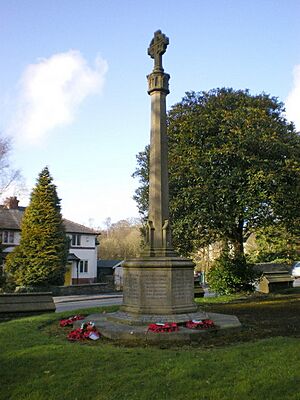Bradshaw, Greater Manchester facts for kids
Quick facts for kids Bradshaw |
|
|---|---|
| OS grid reference | SD735125 |
| Metropolitan borough |
|
| Metropolitan county | |
| Region | |
| Country | England |
| Sovereign state | United Kingdom |
| Post town | BOLTON |
| Postcode district | BL2 |
| Dialling code | 01204 |
| Police | Greater Manchester |
| Fire | Greater Manchester |
| Ambulance | North West |
| EU Parliament | North West England |
| UK Parliament |
|
Bradshaw is a village in Greater Manchester, England. It is part of the Metropolitan Borough of Bolton. Bradshaw is located near the West Pennine Moors. The name Bradshaw is also used for a larger area called an "electoral ward," which includes places like Harwood.
Contents
History of Bradshaw
What's in a Name? (Toponymy)
The name Bradshaw comes from old English words. "Brad" means broad, and "shaw" means a copse (a small group of trees). So, Bradshaw means a broad copse or a wide area with trees. In old documents from the 1200s, it was spelled "Bradeshaye" or "Bradshaigh."
The Bradshaw Family and the Manor
The Bradshaw family owned land here a long time ago. Henry Bradshaw held land in the area in 1235. The Bradshaws were an important family in Lancashire during the late 1500s and early 1600s.
John Bradshaw, who died in 1542, owned the Manor of Bradshaw. Later, in 1694, another John Bradshaw sold the ownership of the Manor of Bradshaw. The land eventually passed to the Isherwood family.
How Bradshaw is Governed
Bradshaw has been part of Lancashire for a long time. From the 1100s until 1974, it was a "township" and "chapelry" of Bolton-le-Moors. A township was a small local area, and a chapelry had its own chapel.
In 1837, Bradshaw joined with other townships to form the Bolton Poor Law Union. This group worked together to help people in need and manage local support systems.
In 1866, Bradshaw became its own "civil parish." This meant it had its own local government for certain matters.
In 1894, Bradshaw became part of the Bolton Rural District. This district was in charge of things like planning, housing, and parks. The Rural District was closed in 1898. Bradshaw then became part of the Turton Urban District.
A big change happened in 1974 because of the Local Government Act 1972. The Turton Urban District was split. The northern part became part of the Borough of Blackburn. The southern part, which included Bradshaw, became part of the Metropolitan Borough of Bolton in Greater Manchester.
Important Places (Landmarks)
The Bradshaw War Memorial is located in the churchyard of St Maxentius' Church, Bradshaw. It remembers the people from Bradshaw who died fighting in the First World War and the Second World War.
One part of the memorial says: To The Glory Of God And In Memory Of The Men Of Bradshaw Who Died For Their Country In The Great War 1914–1918.
At the bottom, there is another message for the Second World War: Also In Loving Remembrance Of The Men Of This Parish Who Gave Their Lives In The War Of 1939–1945.
Other parts of the memorial list the names of all the people who died in both wars. The churchyard also has seven war graves. Six are from the First World War and one is from the Second World War.
Schools in Bradshaw
Bradshaw has two schools for students. They are St Maxentius C.of E. Primary School, located on New Heys Way, and Canon Slade School, on Bradshaw Brow.
Churches and Religious Sites
Bradshaw is known for a special saying: "a tower without a church and a church without a tower." This refers to St Maxentius' Church, Bradshaw. The church was one of the first "chapels of ease" for Bolton Parish Church. A chapel of ease was a smaller church built to serve people who lived far from the main parish church.
The tower, built in the 1500s, is all that remains of the original chapel. The current church building, built in 1872, is near the old tower but stands separately from it.



